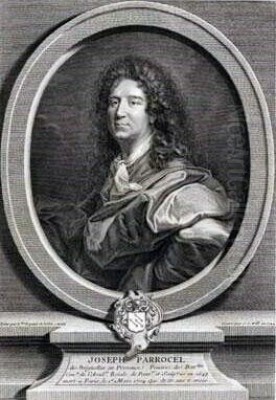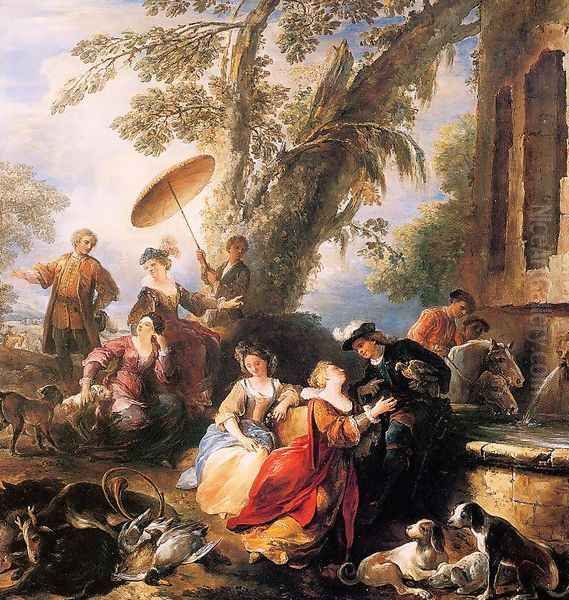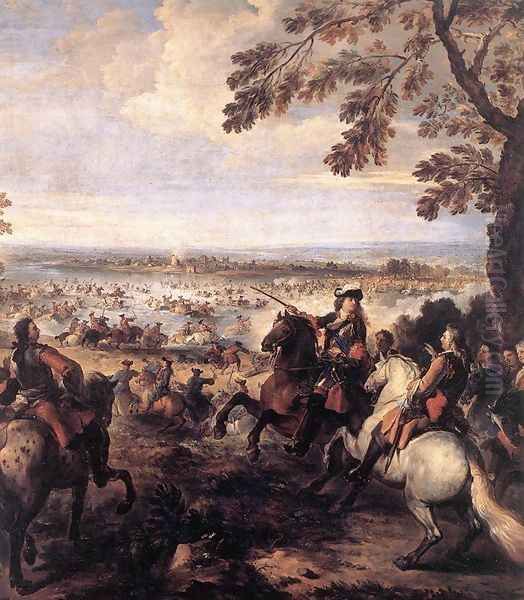
Joseph Parrocel, a prominent figure in French art of the late 17th and early 18th centuries, carved a significant niche for himself as a painter and etcher. Born in 1646 in Brignoles, Provence, and passing away in Paris in 1704, Parrocel's life and career spanned a vibrant period in French history, particularly the opulent reign of King Louis XIV, the Sun King. He became renowned for his dramatic battle scenes, spirited hunting compositions, and religious subjects, all rendered with a characteristic energy and flair that captured the imaginations of his contemporaries and secured his place in the annals of art history.
Early Life and Artistic Foundations
Joseph Parrocel hailed from a veritable dynasty of artists. His father, Barthélemy Parrocel, was a painter, though of lesser renown than some of his descendants. It was, however, from his elder brother, Louis Parrocel, that Joseph likely received his initial artistic instruction after the early death of their father. Some sources also suggest an apprenticeship under another painter in Brignoles. The artistic environment of his family undoubtedly played a crucial role in shaping his early inclinations towards a career in the arts.
Seeking broader horizons and more advanced training, the young Joseph Parrocel made his way to Italy, a near-obligatory pilgrimage for aspiring artists of the era. He is believed to have spent several years there, primarily in Rome and Venice. In Rome, he would have been exposed to the grandeur of High Baroque art, studying the works of masters like Gian Lorenzo Bernini and Pietro da Cortona, whose dynamic compositions and dramatic use of light and shadow left an indelible mark on European art.

His time in Venice was equally formative. The Venetian school, with its rich color palettes and emphasis on atmospheric effects, as exemplified by artists like Titian, Tintoretto, and Veronese, profoundly influenced Parrocel's handling of color and light. It is also said that he encountered and perhaps even worked with Jacques Courtois, also known as "Le Bourguignon" or "Il Borgognone," a French painter active in Italy who specialized in battle scenes. This encounter would have been particularly significant given Parrocel's later specialization. Another artist whose influence can be discerned, particularly in the wild energy of his landscapes and battle scenes, is Salvator Rosa, whose romantic and often turbulent paintings were highly esteemed.
Arrival in Paris and Rise to Prominence
Around 1675, Joseph Parrocel returned to France and settled in Paris, the epicenter of artistic patronage and innovation under Louis XIV. The artistic climate was dominated by the Académie Royale de Peinture et de Sculpture (Royal Academy of Painting and Sculpture), established to promote a distinctly French classical style under the de facto directorship of Charles Le Brun. Le Brun, as First Painter to the King, wielded immense influence over official commissions and artistic taste.
Despite the prevailing classical tendencies championed by Le Brun, Parrocel brought with him a style infused with Italian Baroque dynamism and Venetian colorism. He quickly gained recognition for his skill. In 1676, a pivotal year in his career, Joseph Parrocel was received (agréé) and then fully admitted (reçu) as a member of the Académie Royale. His reception piece was the Siege of Maastricht, a subject that showcased his talent for complex, multi-figured compositions and his ability to capture the drama of warfare. This painting depicted Louis XIV himself at the successful siege in 1673 during the Franco-Dutch War, a theme guaranteed to find favor with the royal establishment.
His membership in the Académie was a significant achievement, granting him official status and access to royal commissions. While he may not have always aligned perfectly with the stricter classical doctrines of Le Brun, his talent was undeniable, and his specialization in battle scenes filled a particular demand.
The Painter of Battles and Hunts
Joseph Parrocel became one of the foremost painters of battle scenes in France, a genre that was particularly popular during the reign of Louis XIV, a monarch whose rule was characterized by numerous military campaigns and a desire to glorify French martial prowess. Parrocel's battle paintings are distinguished by their energy, movement, and often-chaotic compositions that convey the intensity of combat. He excelled at depicting cavalry charges, the clash of swords, and the turmoil of the battlefield, often with a keen eye for the dramatic interplay of light and shadow.

His works in this genre include numerous depictions of Louis XIV's campaigns. These were not merely documentary records but were intended to be heroic and propagandistic, celebrating the glory of the King and the French armies. He competed in this field with other notable artists, most significantly Adam Frans van der Meulen, who was also a favored painter of Louis XIV's military exploits and often accompanied the King on campaigns. While van der Meulen's work was often characterized by a more panoramic and detailed approach, Parrocel's paintings tended to be more focused on the melee and the immediate human drama of conflict.
Beyond large-scale battle pieces, Parrocel also excelled in painting hunting scenes. These subjects, popular among the aristocracy, allowed him to showcase his skill in depicting animals in motion, particularly horses and hounds, as well as the lushness of landscapes. Works like The Boar Hunt and The Return from the Hunt (both c. 1700) exemplify his ability to combine elegant figures with dynamic action in a natural setting. These scenes often carried allegorical or social significance, reflecting the leisured pursuits and status of his patrons.
Royal Patronage: Versailles and Marly
Joseph Parrocel's talents did not go unnoticed by the King and his court. He received several important commissions for the royal residences, most notably the Palace of Versailles and the Château de Marly. At Versailles, the grand stage for Louis XIV's power and glory, Parrocel contributed to the extensive decorative programs. One of his most famous works for Versailles was The Battle of Cassel (1677), depicting a significant French victory. This painting, destined for the War Room (Salon de la Guerre) or a similar prestigious location, would have been part of a larger narrative celebrating the King's military triumphs.
He also worked on decorative schemes for the King's more private retreat, the Château de Marly. While Marly was later destroyed, records and surviving works indicate Parrocel's involvement in creating paintings for its interiors. These commissions placed him in the company of the leading artists of the day, including Charles Le Brun, Pierre Mignard (Le Brun's rival and successor as First Painter), Antoine Coypel, and Jean Jouvenet, all of whom contributed to the artistic splendor of Louis XIV's reign.
The demands of these royal projects were immense, often requiring artists to work on a grand scale and to tight deadlines. Parrocel's ability to produce large, complex, and visually exciting compositions made him a valuable asset to the artistic enterprises of the Crown. His style, while rooted in Baroque traditions, also showed an adaptability that allowed it to fit within the broader decorative aims of these palatial settings.
The Académie Royale: A Continued Presence
As a member of the Académie Royale de Peinture et de Sculpture, Joseph Parrocel was an active participant in the official art world of Paris. The Académie was not just an honorific society; it was the primary institution for artistic training, exhibition, and the dissemination of artistic theory in France. Members were expected to contribute to its activities, which included teaching, delivering lectures, and participating in the regular exhibitions known as Salons (though the Salon system became more formalized later).
In 1703, towards the end of his life, Parrocel was commissioned to create works for the Hôtel des Invalides in Paris, a home for disabled war veterans established by Louis XIV. This commission, for such a significant royal institution, further underscores his esteemed position. While the provided information mentions him becoming an advisor in 1735 and a professor in 1745, these dates fall well after Joseph Parrocel's death in 1704. These later roles within the Académie were achieved by other members of the Parrocel family, most notably his talented nephew, Charles Parrocel (1688-1752), who also specialized in battle scenes and followed in his uncle's footsteps, and perhaps his son, Joseph François Parrocel (1704-1781), who was also a painter and engraver and won the prestigious Prix de Rome. The Parrocel dynasty's deep and continued involvement with the Académie across generations is a testament to their collective artistic talent and standing.
Master of the Etching Needle
Beyond his considerable achievements as a painter, Joseph Parrocel was also a highly skilled and prolific etcher. He produced a significant body of prints, often based on his own designs. His etchings display the same dynamism and flair for dramatic composition found in his paintings. He had a fluid and energetic line, capable of conveying movement and texture with remarkable facility.
Among his most notable series of etchings is "The Miracles of the Life of Jesus Christ," created around 1661, though this date seems early if his Italian sojourn was later. It's possible this series was from a later period or the date refers to an earlier, less mature set. This series, comprising forty-six plates, showcases his ability to interpret religious narratives with originality and emotional depth. Individual prints from this series, such as Christ Calming the Storm, The Baptism of Christ, Jesus Healing the Sick by Touch, and Jesus Christ Tempted on the Pinnacle of the Temple, are admired for their lively handling and expressive power.
His etchings also included hunting scenes and other subjects. The medium of etching allowed for wider dissemination of his compositions and contributed to his reputation. His approach to etching was innovative, often employing a free and almost painterly technique that distinguished his prints from the more formal and engraved style of some of his contemporaries. Artists like Stefano della Bella, who also worked in Paris for a time, had earlier popularized a lively, calligraphic etching style that Parrocel might have admired.
Artistic Style: A Synthesis of Influences
Joseph Parrocel's artistic style is a fascinating amalgamation of various influences, reflecting his training, his travels, and the artistic currents of his time. At its core, his work is imbued with the energy and drama of the Baroque. This is evident in his dynamic compositions, often featuring diagonal thrusts, swirling movement, and figures caught in moments of intense action. His battle scenes, in particular, owe a debt to Italian Baroque masters and specialists in the genre like Jacques Courtois.
From his time in Venice, he absorbed a love for rich, warm colors and an understanding of how to use light and shadow (chiaroscuro) to create atmosphere and heighten drama. While not as overtly theatrical as some Italian Baroque painters, his use of light is often strategic, highlighting key figures or areas of action and plunging others into shadow.
Although working in an era where French Classicism, as championed by Nicolas Poussin and later Charles Le Brun, held considerable sway, Parrocel's style retained a more overt dynamism. However, his compositions are generally well-ordered, demonstrating an underlying structure that prevents them from dissolving into complete chaos, even in his most turbulent battle scenes. There's a sense of controlled energy in his best work.
One can also detect elements that foreshadow the lighter, more graceful Rococo style that would flourish in France after his death, particularly in some of his hunting scenes or mythological subjects. The elegance of his figures and the fluidity of his brushwork hint at this emerging sensibility. Artists like Antoine Watteau, who would become a leading figure of the Rococo, were younger contemporaries, though their primary periods of activity came slightly after Parrocel's peak. There is no record of direct artistic exchange between Parrocel and Watteau, whose thematic concerns and stylistic emphasis differed significantly. Similarly, Louis-Léopold Boilly, known for his genre scenes and portraits, belongs to a later generation, active mainly in the late 18th and early 19th centuries.
Notable Works: A Closer Look
Several key works define Joseph Parrocel's oeuvre and illustrate his artistic strengths:
The Siege of Maastricht (1673 reception piece): This painting was crucial for his acceptance into the Académie. It depicts a specific historical event with Louis XIV present, showcasing Parrocel's ability to handle complex narratives, large numbers of figures, and the depiction of military hardware and action. The composition likely balanced historical accuracy with heroic portrayal.
The Battle of Cassel (1677): Created for Versailles, this work would have been a large-scale depiction of a significant French victory. It would have emphasized the valor of the French troops and the strategic brilliance of their commanders, all under the auspices of Louis XIV. Such paintings were integral to the visual propaganda of the regime.
Hunting Scenes (e.g., The Boar Hunt, The Return from the Hunt, c. 1700): These works demonstrate a different facet of Parrocel's talent. They often feature elegant aristocratic figures, spirited horses, and lively dogs, set against lush landscapes. The compositions are dynamic, capturing the excitement of the chase or the relaxed atmosphere of its aftermath. These paintings appealed to the tastes of the nobility and reflected their lifestyle.
Religious Etchings (e.g., "The Miracles of the Life of Jesus Christ"): This series of prints reveals Parrocel's skill as a draftsman and etcher. The scenes are rendered with a lively, expressive line, conveying the emotional and spiritual intensity of the biblical narratives. His approach to religious imagery was often less formal and more immediately engaging than that of some of his contemporaries.
It's important to note that the attribution of some works can be complicated by the existence of other talented painters in the Parrocel family, particularly his nephew Charles Parrocel, whose style in battle and hunting scenes closely resembled Joseph's.
Controversies, Criticisms, and Anecdotes
Like many artists, Joseph Parrocel was not without his critics, and his career was punctuated by certain professional realities and personal incidents. One notable criticism came from the writer and connoisseur Charles-Antoine Jombert, who, in the 18th century, commented on Parrocel's alleged use of the camera obscura. Jombert suggested that this optical device led to a certain "flattened" appearance in Parrocel's work and an exaggeration of light and color that he found unnatural. The use of optical aids was not uncommon among painters of the period, including artists as renowned as Johannes Vermeer, but it sometimes drew criticism from those who valued unaided observation and traditional draftsmanship.
His work was also sometimes compared, not always favorably, to that of Adam Frans van der Meulen. While both were esteemed battle painters, van der Meulen's meticulous detail and broader topographical views were preferred by some, who found Parrocel's work perhaps lacking in the same degree of finish or depth in certain passages. The high demand for his paintings, particularly battle and hunting scenes, reportedly led Parrocel to delegate parts of his compositions to assistants or collaborators. For instance, it is mentioned that he painted the battle scene in the background of a portrait of the Duke of Burgundy, a common practice where specialists would contribute to different parts of a single canvas. This was a practical necessity for busy workshops but could sometimes lead to unevenness in quality.
His etchings, despite their artistic merit, were apparently sold at relatively low prices during his lifetime, which might have affected their perceived value, though they are now appreciated by collectors and scholars.
A curious anecdote concerns his personal life. After his wife was tragically killed by a lightning strike, a rumor apparently circulated that Joseph Parrocel himself had died. This confusion, coupled with the stylistic similarities between him and his nephew Charles, sometimes led to misattributions of works and a degree of historical entanglement that art historians have since worked to unravel.
The Parrocel artistic dynasty continued to flourish after Joseph's death. His son, Joseph François Parrocel (nicknamed "Parrocel des Gobelins"), became a history painter and designer for the Gobelins tapestry manufactory. His nephew, Charles Parrocel, achieved great success as a battle painter, becoming a member of the Académie and enjoying royal patronage under Louis XV. Other family members, like Étienne Parrocel ("Le Romain"), also pursued artistic careers, primarily in Italy. This continuation of artistic practice within the family for several generations is a remarkable phenomenon in French art history.
Legacy of a Baroque Master
Joseph Parrocel died in Paris in 1704, at the age of 58. He left behind a substantial body of work that significantly contributed to the French school of painting in the late 17th century. His specialization in battle and hunting scenes, rendered with a Baroque dynamism and a rich sense of color, found favor with the most powerful patron of the age, Louis XIV, and the French aristocracy.
His paintings adorned royal palaces and private collections, celebrating military triumphs and aristocratic pastimes. His etchings disseminated his compositions more widely and showcased his skill as a draftsman and printmaker. While perhaps overshadowed in popular historical accounts by figures like Charles Le Brun or, later, Antoine Watteau, Joseph Parrocel was a highly respected and successful artist in his own time.
He successfully navigated the competitive art world of Paris, gaining admission to the prestigious Académie Royale and securing important royal commissions. His style, a blend of Italian Baroque influences and French sensibilities, offered a vibrant alternative to the more rigid classicism that often dominated official art. He influenced subsequent painters of battle scenes, including members of his own family, most notably Charles Parrocel.
Today, Joseph Parrocel's works are held in major museums and collections worldwide, including the Louvre in Paris, the Palace of Versailles, and numerous other institutions. They are valued for their historical significance, their artistic merit, and their vivid portrayal of the martial and courtly life of the Ancien Régime. He remains an important figure for understanding the diversity and dynamism of French art during the grand siècle of Louis XIV, a painter who masterfully captured the energy, drama, and spectacle of his era.